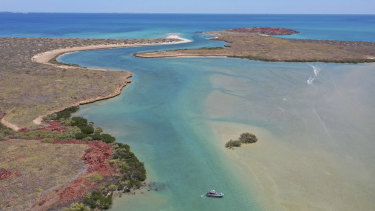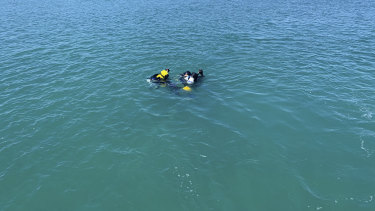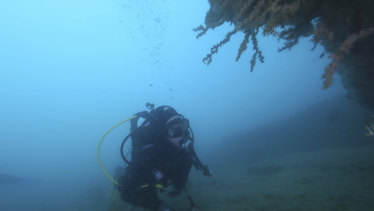The country’s first underwater archaeological site has been discovered off north-west Western Australia, showing Aboriginal people once walked hills and valleys now seen as islands and waters.
But in a fresh example of the tension between heritage and industrial values in the region, these cultural riches are perilously close to an ever-expanding resource operation.
Murujuga is the traditional name for the Dampier Archipelago and surrounds, including the Burrup Peninsula.
On Thursday, an international team of researchers, alongside Murujuga Aboriginal Corporation, announced the discovery of hundreds of stone tools including knives and grinding stones across two sites in the archipelago, that date back at least 7000 and 8500 years.
The research team did not choose Murujuga randomly. The area is a known archaeological hotspot. They also knew that until 5000 years ago, the Dampier Archipelago was once a coastal plain.
For two years they carried out mapping and scanning with increasing precision until by 2019 they were ready to dive.
They found 269 artefacts at Cape Bruguieres, in water 2.4 metres deep. Then on the final day they discovered a second site: a stone knife at Flying Foam Passage, at a freshwater spring 14 metres below sea level.
The team believes there is more to discover at Flying Foam and throughout the area, having now proved artefacts can survive so long, and that the area once supported a dense Indigenous population.
But they have taken “a first step toward exploring the last real frontier of Australian archaeology”, according to Flinders University Associate Professor Jonathan Benjamin, a lead researcher.
He said there were 2 million square kilometres of continental shelf that could fill a major gap in Australian history - or about a third of the current land mass.
He said across Europe, all development assessments now considered underwater archaeology; developer-led archaeological studies had led to significant discoveries in the North and Baltic seas and the Mediterranean.

Cape Bruguieres channel, where the bulk of the artefacts were discovered.
By contrast, he said, in Australia maritime artefacts such as plane or shipwrecks were both better researched and better protected than submerged Indigenous artefacts.
But he expected this discovery to trigger change.
“What we have done is take this from potential to proven,” he said.
“We now have an opportunity to integrate maritime and Indigenous archaeology in Australia.”
Murujuga is the site of increasing conflict between environmental and heritage groups advocating for a World Heritage Listing for the area’s cultural landscape, including its rock art, and oil and gas giant Woodside, which is proposing the major Burrup Hub development.
The new finds lay not in, but near where Woodside plans to dredge for a proposed 430-kilometre pipeline linking the Scarborough gas field to its Pluto LNG plant, part of the hub.
Murujuga Aboriginal Corporation submitted to the Environmental Protection Authority late last year that Woodside had not properly surveyed for heritage sites or addressed potential impacts on the world heritage bid.
They held significant concerns for the fate of the bid, as well as Murujuga intrinsically.
They asked that Woodside fully acknowledge the heritage values, do more to identify any potential sites, and do a risk assessment regarding world heritage criteria.

The project's divers.
The state’s environmental watchdog in January recommended the state government approve the dredging.
It noted MAC’s outstanding concerns but said Woodside’s surveys indicated heritage impacts were unlikely.
It did say Woodside would have to engage with researchers doing submerged landscape studies, to discuss how it might identify potential submerged sites, before proceeding.
WAtoday understands Woodside met with Flinders University researchers.
Two appeals have been lodged against the EPA decision – but traditional owners could not legally lodge one, as they are bound by a legal commitment not to.
A Woodside spokeswoman congratulated the research team and traditional custodians on a "ground-breaking" announcement.
She said while the research was conducted outside Woodside’s area of operation, Woodside was reviewing the report and would further engage with MAC and the research teams to understand it.
She said Woodside was proud of its relationships with traditional custodians and as such supported the World Heritage bid.
It would continue to work with key stakeholders to protect heritage and minimise any impacts both on and offshore, and was consulting with MAC to address their feedback.

A member of the dive team. Credit:Hiro Yoshida
“Woodside is also providing financial and in-kind support for further research into rock art dating and submerged heritage to better understand and publicise any potential heritage values,” she said.
MAC still held concerns about the area, about the potential impacts on the submerged cultural sites and the potential implications for the World Heritage Listing, said chief executive Peter Jeffries, and considered this new research as validation of these concerns.
He said, however, that Woodside had further engaged with MAC this year and there were satisfactory discussions in progress.
He said the study continued efforts to unlock missing links in the region’s cultural heritage and would add to the story of Aboriginal people in the Pilbara.
"These new discoveries prove our ancestors did live and exist on these coastal areas before the sea levels rose after the last ice age, and that not all ancient coastal archaeology is lost," he said.
"It has been exciting to hear what the researchers and specialist scientists have been able to recover ... further exploration could unearth similar cultural relics and help us better understand the life of the people who were so connected to these areas of lands which are now underwater.
Mr Jeffries said plans were progressing to better protect Aboriginal sea country under heritage legislation.
Emma Young is a WAtoday reporter focusing on environmental issues, urban planning, social justice and the arts. She has won seven WA Media Awards, including the Matt Price Award for Best Columnist.
Most Viewed in National
https://news.google.com/__i/rss/rd/articles/CBMilgFodHRwczovL3d3dy5zbWguY29tLmF1L25hdGlvbmFsL2ZpbmFsLWZyb250aWVyLW9mLWF1c3RyYWxpYW4tYXJjaGFlb2xvZ3ktZHJvd25lZC1hcnRlZmFjdHMtcmV2ZWFsLWZpcnN0LXVuZGVyd2F0ZXItaGVyaXRhZ2Utc2l0ZXMtMjAyMDA3MDEtcDU1ODZmLmh0bWzSAZYBaHR0cHM6Ly9hbXAuc21oLmNvbS5hdS9uYXRpb25hbC9maW5hbC1mcm9udGllci1vZi1hdXN0cmFsaWFuLWFyY2hhZW9sb2d5LWRyb3duZWQtYXJ0ZWZhY3RzLXJldmVhbC1maXJzdC11bmRlcndhdGVyLWhlcml0YWdlLXNpdGVzLTIwMjAwNzAxLXA1NTg2Zi5odG1s?oc=5
2020-07-01 22:42:12Z
52780891252975
Bagikan Berita Ini














0 Response to "'Final frontier of Australian archaeology': Drowned artefacts reveal first underwater heritage sites - Sydney Morning Herald"
Post a Comment